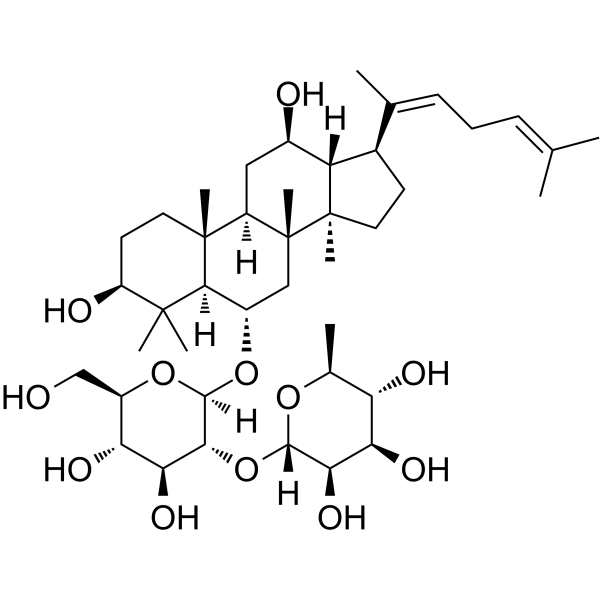
Ginsenoside Rg4
CAS No. 126223-28-7
Ginsenoside Rg4( —— )
Catalog No. M29152 CAS No. 126223-28-7
Ginsenoside Rg4 is isolated from the leaves of Panax ginseng C. A. Meyer. Ginsenoside Rg4 is a protopanaxatriol type ginsenoside with anti-septic, anti-diabetic, wound healing, immune-stimulatory, and anti-antioxidant properties.
Purity : >98% (HPLC)
 COA
COA
 Datasheet
Datasheet
 HNMR
HNMR
 HPLC
HPLC
 MSDS
MSDS
 Handing Instructions
Handing Instructions
| Size | Price / USD | Stock | Quantity |
| 5MG | 290 | Get Quote |


|
| 10MG | 470 | Get Quote |


|
| 25MG | 750 | Get Quote |


|
| 50MG | 1008 | Get Quote |


|
| 100MG | Get Quote | Get Quote |


|
| 200MG | Get Quote | Get Quote |


|
| 500MG | Get Quote | Get Quote |


|
| 1G | Get Quote | Get Quote |


|
Biological Information
-
Product NameGinsenoside Rg4
-
NoteResearch use only, not for human use.
-
Brief DescriptionGinsenoside Rg4 is isolated from the leaves of Panax ginseng C. A. Meyer. Ginsenoside Rg4 is a protopanaxatriol type ginsenoside with anti-septic, anti-diabetic, wound healing, immune-stimulatory, and anti-antioxidant properties.
-
DescriptionGinsenoside Rg4 is isolated from the leaves of Panax ginseng C. A. Meyer. Ginsenoside Rg4 is a protopanaxatriol type ginsenoside with anti-septic, anti-diabetic, wound healing, immune-stimulatory, and anti-antioxidant properties.
-
In Vitro——
-
In Vivo——
-
Synonyms——
-
PathwayGPCR/G Protein
-
TargetAntibacterial
-
RecptorAntibacterial
-
Research Area——
-
Indication——
Chemical Information
-
CAS Number126223-28-7
-
Formula Weight767.01
-
Molecular FormulaC42H70O12
-
Purity>98% (HPLC)
-
Solubility——
-
SMILES[H][C@@]12[C@H](CC[C@@]1(C)[C@]1(C)C[C@@H](O[C@@H]3O[C@H](CO)[C@@H](O)[C@H](O)[C@H]3O[C@@H]3O[C@@H](C)[C@H](O)[C@@H](O)[C@H]3O)C3C(C)(C)[C@H](O)CC[C@]3(C)[C@@]1([H])C[C@@H]2O)C(\C)=C/CC=C(C)C
-
Chemical Name——
Shipping & Storage Information
-
Storage(-20℃)
-
ShippingWith Ice Pack
-
Stability≥ 2 years
Reference
molnova catalog



related products
-
MSX-127
MSX-127 elicites positive response in peptide CXCR4.
-
Flagelin 22
Flagelin 22 (Flagellin 22), a fragment of bacterial flagellin, is an effective elicitor in both plants and algae.
-
DIMBOA
DIMBOA, an antibiotic, is a benzoxazinoid, part of the chemical defense system of graminaceous plants such as maize, wheat, and rye.



 Cart
Cart
 sales@molnova.com
sales@molnova.com


